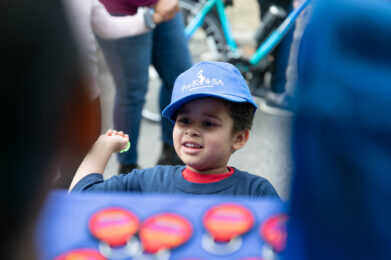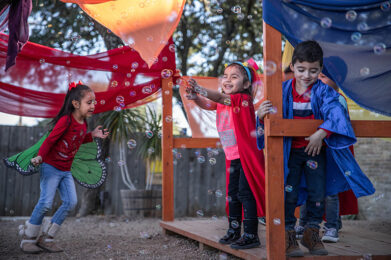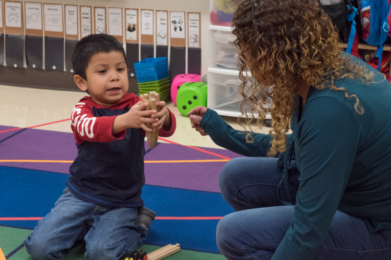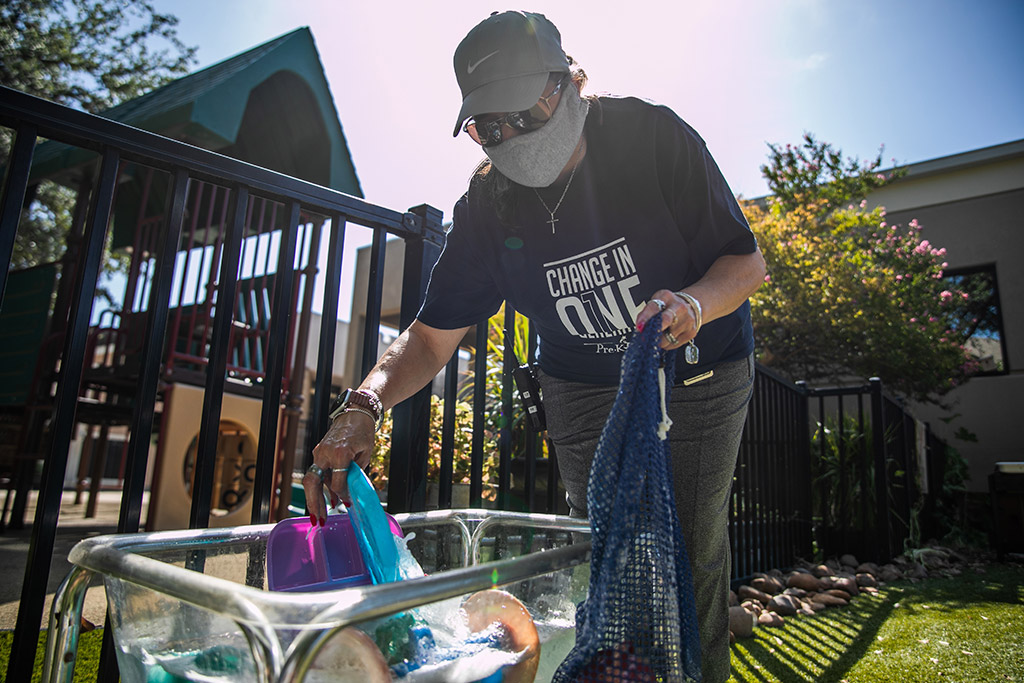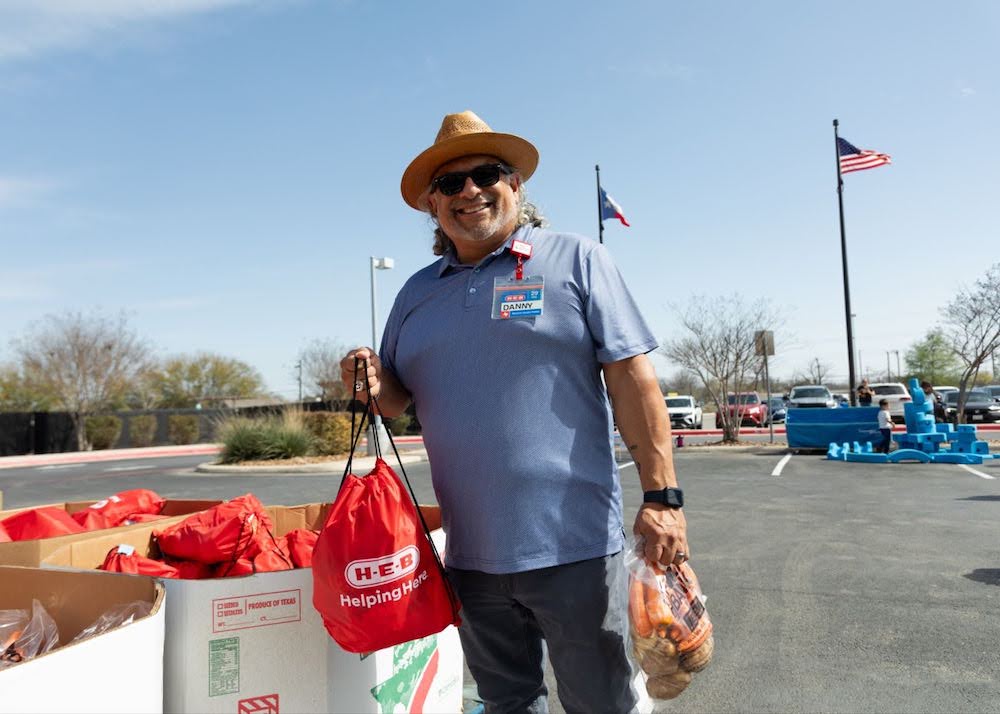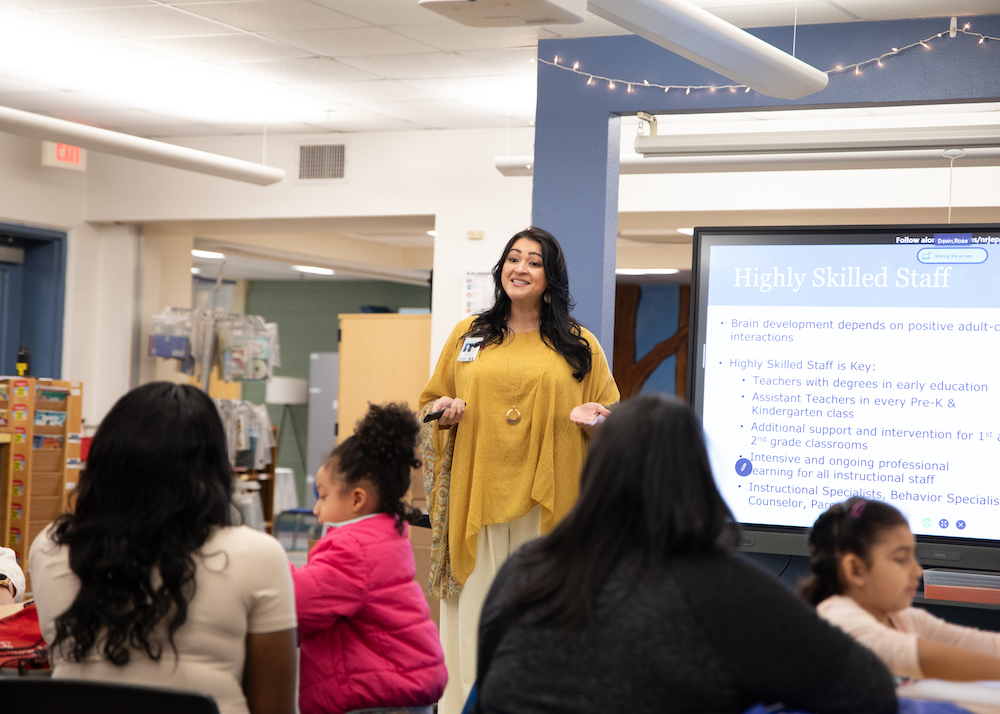As we prepare to open the doors at all four of our Pre-K 4 SA Education Centers, we have developed a three-prong COVID-19 response strategy designed to keep our children, families, and staff safe and healthy:
1) Keep the virus out of our buildings;
2) Reduce the chance of an outbreak; and
3) Respond quickly to a potential COVID exposure.
With new safety features and sanitation protocols to prevent the spread of COVID-19 set in place, our 2020-2021 school year will look different from previous years. These protocols and procedures will be evident from the very moment a child arrives at the Education Center or bus depot to the moment the family picks up the child at the end of the day.
Although COVID-19 has disrupted our normal way of life, we want the children in this year’s cohort to have the same sense of wonder and awe that previous groups of children experienced at Pre-K 4 SA. Young children learn through play, which includes active exploration and tactile interactions. To ensure children are able to safely move about the room and touch instructional materials, Pre-K 4 SA has developed a sanitation plan that allows children to go about their normal classroom activities and then place used items in a cleaning bin to be sanitized by staff. This approach makes cleaning and sanitizing a normal part of the classroom routine and avoids creating a sense of fear about being in the classroom or using materials.
Teaching children healthy habits has always been part of the Pre-K 4 SA approach. We teach children how to brush their teeth, eat vegetables, and properly wash their hands because those are things we do to keep ourselves happy and healthy. This year, we are adding new lessons that teach children the proper way to put on their masks and face shields and the importance of handwashing and sanitation as part of a general routine of safety and healthfulness.
What does all this look like in practice? Read below about a typical day at Pre-K 4 SA in the 2020-21 school year.
Daily Drop-off
As families arrive for morning drop-off, they are directed to pull up to designated curbside locations where they are greeted by a Pre-K 4 SA staff member who is wearing a mask, face shield and gloves. Families remain in their vehicle and use our new contactless smartphone application, ProCare, to begin the check-in process. The app guides families through the COVID health screening questions while the Pre-K 4 SA staff member uses a touchless thermometer to take the child’s temperature. Once the health screening is complete, a secure one-time QR code pops up on the Center’s device.
The staff member scans the code to automatically update the system to alert the classroom teacher that the child has arrived and is on the way to the classroom. The child puts on a face mask and exits the car with the staff member. The staff member escorts the child into the building where they stop at the hand sanitizing station and then onto the classroom. The staff member scans the child in on the teacher’s iPad to complete the check-in process. [Note: Families without a smartphone may use a Pre-K 4 SA iPad to complete this process.]
The protocol for families that elect to use Pre-K 4 SA transportation is similar, but with a few added safety protocols for the bus. As families arrive at the bus depot, they are directed to pull into designated parking spots. Families remain in their vehicles and use the smartphone app to begin the check-in process. The app guides families through COVID health screening questions. Once the health screening is complete, a secure one-time QR code pops up on the Center’s device. The parent and child put on their face masks and walk to the bus loading zone where a Pre-K 4 SA staff member is waiting.
The staff member takes the child’s temperature, scans the QR code and escorts the child onto the bus where they are greeted by a driver wearing protective gear. Children are seated in a 5-point harness safety seat, from the back of the bus to the front, in designated spots to allow adequate social distancing. Instruction begins as soon as the bus begins moving, with the staff member leading the children in songs and rhyming games. When the bus arrives at the Education Center, the staff member unloads the children from front to back and escorts the children to the classroom, stopping by the hand sanitizing station on the way. Once in the classroom, each child is checked-in on the teacher’s iPad.
In the Classroom
Pre-K 4 SA will provide all supplies for the children, including personal items like water bottles and nap blankets. These items will remain at Pre-K 4 SA and we will take responsibility for sanitizing them. Additionally, any item brought into the building by an adult (e.g., purse, lunch bag) will be sanitized upon entry.
As children arrive in the classroom, they put away their cloth face mask and put on their face shield before joining the teacher for a read aloud. Face shields ensure children’s coughs and sneezes are covered and are more comfortable than face masks for children to wear for long periods of time. Having no more than 10 children in a classroom designed for 20, provides plenty of room for the children to spread out. The classrooms are sanitized daily and the HVAC systems have been modified to provide better air filtration and more fresh air.
One by one, the children wash their hands and select a seat at the table. Plexiglass table dividers allow children and teachers to safely sit near one another. Children eat a healthy, individually packaged meal while the teacher engages them in conversation to support language development.
After breakfast, children wash their hands and find a place on the large floor rug. Each child is individually greeted and welcomed as the child sits down. The teacher shares the schedule for the day, which is written on a dry erase easel all the children can see. The teacher discusses any news or changes to the schedule. Children share their own news and are encouraged to comment and make suggestions about the day’s schedule. Then it’s time for the teachers and children stand up and spread out so they can express themselves through movement and music. The children take turns being the leader by selecting the type of movement activity and encouraging the other children to share in the fun.
After movement, the children select a seat at the table for small group instruction. Each child is given a box of learning materials. To the children, it looks like they all have the same materials. But the teacher has carefully individualized the boxes based on each child’s interests and developmental needs. The teacher demonstrates what the children are expected to do with the materials in their boxes and then the children have time to practice using their own materials while the teacher observers and guides the learning. After small group, it’s time to head outside to one of the outdoor learning environments that has been specially designed to engage children in learning through nature. Whether the children are tending to their gardens, playing restaurant in the mud kitchen, or staging a production on the outdoor stage, the children are supported in developing not only their gross motor skills, but also foundational academic thinking. When outdoor learning time is over, children wash their hands as they return to the classroom for work time.
Work time includes three distinct activities:
1) Plan: A 10- to 15-minute period during which children plan what they want to do during work time (the area to visit, materials to use, and friends to play with);
2) Do: A 40- to 60-minute worktime for children to carry out their plans (or shift to new activities that interest them); and
3) Review: A 10- to 15-minute period to review and recall with the teacher and to discuss what they did and learned.
Engaging in plan, do, and review helps children develop executive function skills, which are essential not only to success in school, but also in career and life.
Lunch Time
The completion of work time marks brings us to the end of the morning, so it’s time for lunch. The teacher reads aloud while children take turns washing their hands. Children select a seat at a table with plexiglass dividers. The teacher uses gloves to serve each child an individually packaged meal. The teacher engages the children in conversation to support language development. As children finish their meal, they clean up their space, and put out their rest mat, being mindful to allow ample space between each mat.
Children take this time to rest quietly on their mats. Having a rest time helps children become more self-aware and regulate their emotions, as well as helps them gain more energy for the other half of the day. Many children sleep during this time, but they are not required to do so. As the children get up from rest time, they join the teacher for story time. The teacher focuses on literacy skills while reading a book or telling a story. After the story, children once again have the opportunity to express themselves through music and movement. The rest of the afternoon is filled with another small group time, more time outside, and a second worktime, which provides children with the opportunity to continue what they were working on in the morning or to select a whole new project.
Daily Pick-up from Education Center
Staggered dismissal times allow the children in each classroom to be safely escorted outside where their families are waiting for curbside pick-up. When a parent is at the curbside pick-up and signs into the app, the Center will be notified that the parent has arrived. A staff member will escort the child to the car and the parent will scan the QR code on the Center’s device to check-out the child. This automatically updates the system to indicate the child has been safely returned to the family.
Daily Pick-up from Bus Depot
At dismissal, the same bus monitor goes to the children’s classroom to pick them up and take them to their designated buses. He or she helps the children get on the bus and makes sure all children are buckled in safely. Children will be sitting separately, and bus monitors will be keeping an empty row of seats between children to maintain social distance. The windows on the bus will be slightly open to allow natural airflow. During the bus ride to the bus depot, the bus monitor will be wearing a mask and shield and will engage children in songs. Once they arrive at the bus depot, the monitor will greet parents, who will sign out their child using ProCare, our new contactless smartphone application. The bus monitor will take a picture of the parent QR code which will automatically sign out each child.
Our Pre-K 4 SA departments have all worked earnestly to make sure our Education Centers are ready for whenever we open our doors to San Antonio’s 4-year-olds. Pre-K 4 SA is here to continue providing a safe and welcoming environment where children can continue learning and receive a high-quality early childhood education.
Written by: Sarah Baray, Pre-K 4 SA CEO
